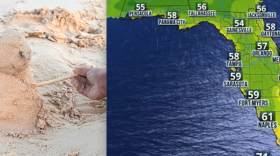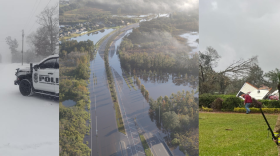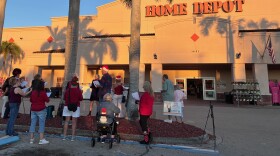Across the road from a snack shack in Fort De Soto Park, Gary Raulerson searches until he finds a gap in the cabbage palms. He ducks inside, branches creaking on a bright February morning. He plods a few steps past an orange survey flag.
Sunlight slashes through dead Brazilian pepper trees, brought here more than a century ago for decoration, now invasive. Raulerson tries to avoid poison ivy. Sweat pricks his back.
In the parking lot, University of Florida researchers prepare a spider-like drone, which will fly an $80,000 laser radar device to collect data on the vegetation.
Scientists are studying nine places like this around Tampa Bay, where water meets land and where they believe the region’s present will meet its uncertain future as seas rise.
An ecologist for the Tampa Bay Estuary Program, Raulerson, 52, wears transition lenses under long gray hair and cinches a bucket hat at his neck. He hopes this study, still in its infancy, will outlast him by decades. Climate change, he believes, is legacy work.
“We think about the impacts it’s going to have on our houses, on our infrastructure,” he said — on places like the sugar-sand beach across the street, rated among America’s best. Just a Frisbee toss away, the tangled wedge of the barrier island where Raulerson stands lacks such glamour, but he worries about it just the same.
He wonders what will become of the mangroves and marsh grasses that share the shore, squeezed somewhere between the pavement and rising tide.
* * *
The Tampa Bay Estuary Program’s watch sites encircle the region, from Hidden Harbor Park in Parrish to Oldsmar’s Harbor Palms Nature Park and down to Fort De Soto.
Researchers break each of the nine locations into sections, counting the plants by hand. They dig holes, Raulerson said, until they reach the puddling groundwater, which they test for salinity. They started in 2016 and plan to check the sites roughly every 3 to 5 years.
The University of Florida joined recently, in search of partners for whom they could provide drone analysis on the Gulf Coast. They’re also flying above oyster beds at Cedar Key.
An undergraduate student, Connor Bass, steers the drone in figure-8s, battling the wind to get the machine calibrated. Then he lets it fly over an automated path, recording elevation data on the vegetation below. Almost instantly, the results pop onto a computer screen monitored by post-doc researcher Andrew Lassiter, in blue and green lines shaded by height. In those pixels, they see the size and shape of an ecosystem. Another pilot, Ali Gonzalez Perez, flies a smaller drone with a camera that records color and infrared images.
Their work delivers quick results, but Raulerson does not expect the Estuary Program to have definitive findings for as long as a couple of decades. Change will come slowly, he said, but he has an idea of what it might look like:

As the sea encroaches, salt- and water-resilient species like mangroves move with it, and less tolerant plants, including some buttonwood shrubs and palms, retreat upland. Over an endless expanse this might play out as a natural process, the shoreline shrinking and swelling in proportion to the water. But at the Fort De Soto site, the road is just 130 feet away.
A panel of scientists, citing National Oceanic and Atmospheric Administration projections, has said that by 2050, seas could rise in St. Petersburg between almost 1 foot and 1 foot 10 inches.
This presents a management problem, Raulerson said. He hopes the study will inform how people respond.
“How do we protect the houses and the habitats at the same time?” he asked.
The answer is not yet obvious.
Those clued into the Estuary Program’s effort have passed around a photograph, taken by a consultant in 2014 near the mouth of the Alafia River. It shows an ashen white cypress stump in a salt barren. Such trees thrive in freshwater. But already, this one sits alone — a withering memorial to a landscape in transition.
* * *
Raulerson remembers boyhood trips to Fort De Soto, racing his skimboard over the mud flats, falling into a bloom of jellyfish. He camped near lush coastal marshes and swam in blue springs. It was by building tables for the Enoch Davis Recreation Center on 18th Avenue S that he made Eagle Scout.
In college, he tried music but pivoted to ecology, drawn to the wild playgrounds of his youth.
Some advocates make dire predictions for what will befall Florida’s coastline, the vibrant estuaries and uplands that fringe Tampa Bay. To Raulerson, it remains not just a reminder of the stakes but a stress release. Walking down a trail, he said, “eases that burden.”
Cutting deeper into the thicket at Fort De Soto, he reaches muddy ground — the edge of the current tide. White mangroves, up to his eyes, dominate the landscape. Just beyond is Soldier Hole and Mullet Key Bayou, water that separates the watch site from the park’s campground.
It’s home to egrets, spoonbills and herons, Raulerson explained, along with redfish, snook and trout. His focus on nature only goes so far, though, before people crowd into view.
He wonders what will become of the bird watchers, anglers and kayakers — the Floridians who, like him, love this place — as the exact balance of the tidal zone shifts. And what, too, will happen to Tierra Verde, with million-dollar homes buffered from storm surge by mangroves and marshland?
“We’re part of these areas,” Raulerson said.
Behind the wall of palms, the whoosh of cars cuts through the leaves.
This story was produced by the Florida Climate Reporting Network, a multi-newsroom initiative that includes the Miami Herald, the Sun-Sentinel, The Palm Beach Post, the Orlando Sentinel and the Tampa Bay Times.
WLRN depends on donors to remain South Florida's leading nonprofit, most trusted source of news and information. Support our mission by giving monthly as a sustaining member of Friends of WLRN or make a one-time donation of your choice. Thank you. Click here to give.
Copyright 2020 WLRN 91.3 FM. To see more, visit .9(MDAyMTYyMTU5MDEyOTc4NzE4ODNmYWEwYQ004))







